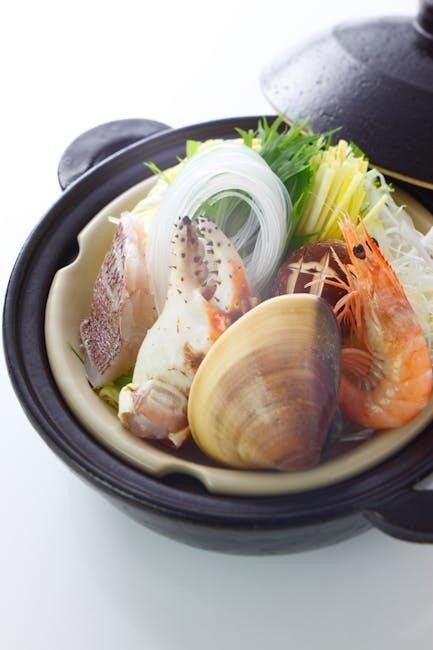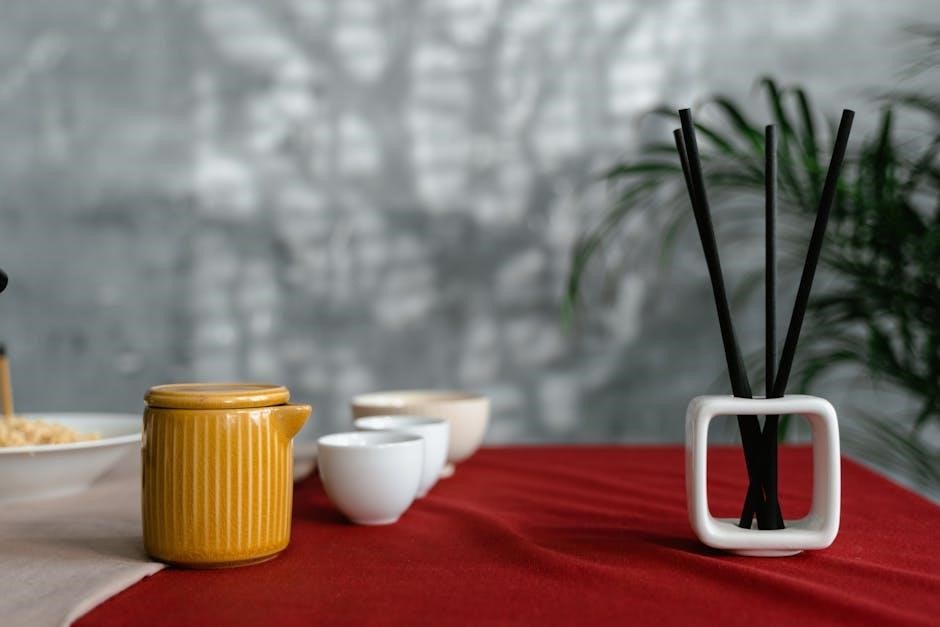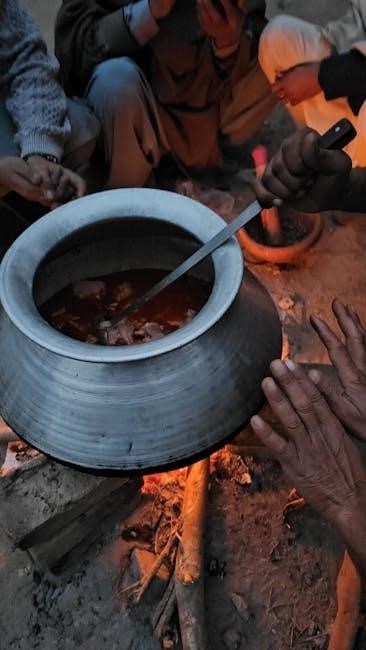Mastering Instant Pot cooking times is essential for perfect meals․ This guide provides a printable PDF chart for meats, seafood, vegetables, eggs, rice, grains, and beans․
It ensures optimal cooking results with precise times, liquid requirements, and release methods, helping you cook over 50 ingredients efficiently․ Download and print for quick reference!
Why Cooking Times Matter in Pressure Cooking
Cooking times are crucial for achieving perfect results in pressure cooking․ They ensure food is tender, flavorful, and safe to eat․
Undercooking can leave ingredients tough or raw, while overcooking may result in mushy textures․ Accurate timing helps preserve nutrients and enhances the overall dining experience․
A reliable guide, like an Instant Pot cooking times PDF, provides consistency and confidence, especially for beginners․ It eliminates guesswork, ensuring dishes turn out as intended every time․
Benefits of Using a Cooking Times Chart
A cooking times chart offers convenience and efficiency in the kitchen․ It provides quick access to precise cooking times for various ingredients,
eliminating the need to search for recipes repeatedly․ This handy reference ensures consistency, helping you achieve perfectly cooked meals every time․
Whether you’re preparing meats, vegetables, grains, or beans, a chart streamlines the cooking process, saving time and reducing the risk of under or overcooking․
It’s an essential tool for both new and experienced Instant Pot users, making meal prep faster and more enjoyable․
How to Use the Instant Pot Cooking Times PDF
The Instant Pot Cooking Times PDF is a handy guide that simplifies pressure cooking․ Download and print it for easy access or save it on your mobile device․
The chart lists precise cooking times, liquid requirements, and release methods for various ingredients like meats, seafood, vegetables, grains, and beans․
Refer to it while cooking to ensure perfect results․ It’s organized by food type, making it easy to find the information you need quickly․
This PDF is ideal for both beginners and experienced users, helping you cook efficiently and consistently every time․
Cooking Times for Meats
Discover the perfect cooking times for various meats in your Instant Pot․ From beef ribs and roasts to chicken breasts and thighs, and pork chops to lamb shanks, this guide ensures tender results every time with precise timing for each cut․
Beef Cooking Times: Ribs, Roasts, and Ground Beef
Cooking beef to perfection in the Instant Pot requires precise timing․ Beef ribs typically take 25-35 minutes, while roasts like chuck or brisket need 40-50 minutes for tender results․ Ground beef cooks quickly, usually within 5-10 minutes, making it ideal for weeknight meals․ The cooking times vary based on the cut and desired tenderness․ Ensure adequate liquid, as a minimum of 1 cup is recommended for pressure cooking․ For ribs and roasts, natural pressure release (NPR) is best, while ground beef often uses quick release (QPR)․ This guide ensures flavorful, perfectly cooked beef every time!
Chicken Cooking Times: Breasts, Thighs, and Whole Chicken
Cooking chicken in the Instant Pot is quick and effortless․ Boneless chicken breasts typically require 8-12 minutes, while thighs take 10-15 minutes for tender results․ A whole chicken cooks in 20-25 minutes, ensuring juicy meat․ Always use at least 1 cup of liquid for proper pressure cooking․ For breasts and thighs, a quick pressure release (QPR) works best, while a natural pressure release (NPR) is ideal for a whole chicken․ This guide ensures perfectly cooked chicken every time, whether you’re making shredded, roasted, or meal-prep dishes․ Adjust times based on size and desired doneness for optimal flavor and texture․
Pork Cooking Times: Pork Chops, Carnitas, and Shoulder
Cooking pork to perfection is easy with the Instant Pot․ Pork chops typically require 8-12 minutes, while carnitas need 20-25 minutes for tender, flavorful results․ A pork shoulder cooks in 30-40 minutes, yielding fall-apart meat․ Always use at least 1 cup of liquid for proper pressure cooking․ For chops and carnitas, a quick pressure release (QPR) works well, while a natural pressure release (NPR) is best for shoulders to ensure tenderness․ This guide helps you achieve perfectly cooked pork every time, whether you’re making tacos, roasts, or hearty stews․ Adjust times based on size and desired texture for the best results․
Lamb Cooking Times: Shanks, Stew, and Roasts
Cooking lamb in the Instant Pot is a game-changer for tender, flavorful results․ Lamb shanks typically require 25-30 minutes, while lamb stew cooks in 20-25 minutes for hearty, fall-apart texture․ Roasts, such as leg of lamb, need 25-35 minutes, depending on size․ Always use at least 1 cup of liquid for proper pressure cooking․ A natural pressure release (NPR) of 10-15 minutes is recommended for lamb to ensure tenderness․ This guide helps you achieve perfectly cooked lamb dishes, from comforting stews to impressive roasts, with precise timing and liquid ratios for the best results every time․
Cooking Times for Seafood
Discover perfect cooking times for seafood in your Instant Pot․ From fish to shrimp, mussels, and clams, this guide ensures tender, flavorful results with quick cooking times and tips․
Fish Cooking Times: Salmon, Cod, and Tilapia
Cooking fish in the Instant Pot is quick and effortless․ Salmon typically cooks in 2-4 minutes, while cod and tilapia require 3-5 minutes․
Use a 10-15 minute natural pressure release for flaky, tender results․ Ensure minimal liquid, around 1 cup, for optimal cooking․
This guide provides precise times for fresh or frozen fish, ensuring perfectly cooked seafood every time․ Avoid overcooking with these easy-to-follow instructions․
Shrimp Cooking Times: Fresh and Frozen
Shrimp cooks quickly in the Instant Pot, requiring just 1-2 minutes for fresh and 2-3 minutes for frozen․
Use a quick pressure release for tender results․ Add 1 cup of liquid, such as broth or water, for proper cooking․
This guide ensures perfectly cooked shrimp every time, whether fresh or frozen, with easy-to-follow instructions for optimal texture and flavor․

Mussels and Clams Cooking Times
Mussels and clams cook quickly in the Instant Pot, typically requiring 2-4 minutes of cooking time․
Add 1-2 cups of liquid, such as broth or water, for proper steaming․
Use a quick pressure release to prevent overcooking and ensure tender, flavorful results․
This guide provides precise times for fresh or frozen shellfish, helping you achieve perfectly cooked seafood every time․
Ideal for soups, stews, or standalone dishes, the Instant Pot simplifies cooking mussels and clams with ease and consistency․
Cooking Times for Vegetables
This guide provides tailored cooking times for various vegetables, ensuring perfect results․ From root vegetables like potatoes and carrots to leafy greens and more,
it offers precise durations for optimal texture and flavor, helping you cook vegetables to perfection in your Instant Pot․
Root Vegetables: Potatoes, Carrots, and Beets
Cooking root vegetables in the Instant Pot is quick and effortless․ Potatoes cook in 8-12 minutes, depending on size, while carrots take 5-8 minutes for whole or sliced pieces․
Beets require 15-20 minutes for tender results, especially when peeled and halved․ The guide provides precise times for various preparations, ensuring perfectly cooked vegetables every time․
With minimal liquid and the right pressure settings, you can achieve ideal texture and flavor for these hearty staples․ This section is a must-reference for mastering root vegetables in your Instant Pot․
Leafy Greens: Spinach, Kale, and Broccoli
Cooking leafy greens in the Instant Pot is quick and nutritious․ Spinach cooks in just 1-2 minutes, perfect for adding to soups or sautés․ Kale takes 3-5 minutes for tender leaves,
while broccoli requires 3-5 minutes for crisp-tender florets․ The guide offers specific times for fresh or frozen greens, ensuring they retain their vibrant color and nutrients․
With minimal effort, you can prepare healthy, flavorful greens to complement any meal․ This section is a go-to for achieving perfectly cooked leafy greens every time․
Other Vegetables: Corn, Peas, and Cauliflower
Cooking corn, peas, and cauliflower in the Instant Pot is quick and effortless․ Corn on the cob cooks in 2-3 minutes, yielding tender, flavorful kernels․ Peas require just 1-2 minutes,
preserving their vibrant color and texture․ Cauliflower florets cook in 4-6 minutes, perfect for soups, side dishes, or as a low-carb substitute․ The guide provides precise times for fresh
or frozen options, ensuring optimal results․ These vegetables are versatile and easy to prepare, making them a great addition to any meal․ This section is a handy reference for
cooking these popular vegetables to perfection every time․

Cooking Times for Eggs
Easily cook eggs to perfection with the Instant Pot․ Hard-boiled eggs cook in 5-6 minutes, while soft-boiled take 3-4․ Egg bites and poached eggs also have specific times for ideal texture and easy peeling․

Hard-Boiled Eggs in the Instant Pot
Cooking hard-boiled eggs in the Instant Pot is quick and effortless․ Place 1-12 eggs in a steamer basket, add 1 cup of water, and cook on high pressure for 5-6 minutes․
After cooking, allow a 5-minute natural release before quick-releasing any remaining pressure․ This method ensures perfectly cooked yolks and easy peeling․ The Instant Pot eliminates the need for constant monitoring, delivering consistent results every time․
This technique is ideal for meal prep or snacks, with eggs ready in under 15 minutes total․ Say goodbye to overcooked or undercooked eggs!
Soft-Boiled Eggs and Egg Bites
Soft-boiled eggs and egg bites are perfectly cooked in the Instant Pot for a delicious, runny yolk and set white․ Place eggs in a steamer basket with 1 cup of water․
Cook on high pressure for 3-4 minutes, followed by a quick release․ For egg bites, pour whisked eggs into molds, add water, and cook for 5-7 minutes․
This method ensures tender, creamy results without overcooking․ Ideal for breakfast or snacks, soft-boiled eggs and egg bites are easy to prepare and customizable with seasonings or fillings․
Cooking Times for Rice and Grains
Cook perfect rice and grains with precise Instant Pot times․ White, brown, and jasmine rice, plus quinoa, cook effortlessly with minimal effort․ Use the PDF guide for quick reference․
White Rice, Brown Rice, and Jasmine Rice
Cooking rice in the Instant Pot is simple with the right times․ White rice cooks in 4-6 minutes, while brown rice takes 15-20 minutes․ Jasmine rice, slightly shorter at 4-5 minutes, ensures fluffy results․ Use a 1:1 water ratio for white and jasmine, and 1․2:1 for brown․ Natural release is best for all types․ The PDF guide offers precise measurements and tips for perfect grains every time, making meal prep effortless and stress-free․ Achieve consistent results with this handy reference for all your rice needs․
Quinoa and Other Grains
Quinoa cooks perfectly in the Instant Pot in just 1-2 minutes with a 1:1․25 water ratio, using natural release․ Other grains like farro and bulgur also thrive with quick cooking times․
Farro typically takes 6-8 minutes, while bulgur cooks in 3-4 minutes․ The PDF guide provides exact measurements and tips for each grain, ensuring fluffy, tender results․
Rinse grains before cooking to enhance flavor and texture․ This section is your go-to for mastering quinoa and other grains, making meal prep a breeze with precise timing and ratios․
Cooking Times for Beans and Lentils
Cook beans and lentils to perfection with precise Instant Pot times․ Black beans, kidney beans, and chickpeas cook in 15-20 minutes, while lentils take 8-12 minutes․
This guide ensures tender results with minimal effort, covering various types and soaking options for optimal texture and flavor․
Black Beans, Kidney Beans, and Chickpeas
Cooking black beans, kidney beans, and chickpeas in the Instant Pot is efficient and quick․ Black beans and kidney beans typically cook in 15-20 minutes without soaking, while chickpeas may take 20-25 minutes․
Soaking beans can reduce cooking time by about 5 minutes․ Use a 1:2 ratio of beans to liquid, and season for added flavor․ For best results, allow natural pressure release for 10-15 minutes․
This method ensures tender, flavorful beans perfect for salads, stews, or sides․ Adjust cooking times slightly for soaked vs․ unsoaked beans and monitor texture for desired doneness․
Lentils: Green, Red, and Beluga
Cooking lentils in the Instant Pot is quick and easy․ Green and brown lentils typically cook in 15-20 minutes, while red lentils soften faster, requiring only 5-10 minutes․
Beluga lentils, known for their dark color, cook in 15-20 minutes․ Use a 1:2 ratio of lentils to liquid, and season as desired․
Lentils are perfect for soups, stews, or salads․ For firmer texture, cook for 5 minutes less․ Natural pressure release works best for even cooking․
This method ensures tender, flavorful lentils with minimal effort, making them a great protein-packed addition to any meal․

Understanding Liquid Requirements
Proper liquid levels are crucial for Instant Pot cooking․ Always use at least 1 cup of liquid for 6-quart models to ensure pressure builds safely․
Adjust amounts based on food type and desired texture․ Excess liquid can lead to mushy results, while too little may cause burning․
Refer to the PDF guide for specific ratios to achieve perfect doneness every time, ensuring flavorful and tender meals without undercooking or overcooking․

Minimum Liquid Needed for Pressure Cooking
The Instant Pot requires a minimum of 1 cup of liquid for 6-quart models to build pressure safely․
This ensures proper cooking and prevents burning․ For smaller pots, adjust proportions accordingly․
Excess liquid can dilute flavors, while too little may cause undercooking or safety issues․
Use the PDF guide for specific ratios to avoid guesswork․
Remember, liquid needs vary with food type, but the base requirement remains essential for optimal results․
Always consult the chart for precise measurements to ensure your dishes turn out perfectly cooked and flavorful․
Adjusting Liquid for Different Foods
Adjusting liquid is crucial for perfect Instant Pot results․ Denser foods like beans or meats require more liquid, while delicate items like fish or vegetables need less․
The PDF guide provides specific ratios to ensure proper cooking without over-diluting flavors․
For example, grains like rice typically need a 1:1 ratio, while beans may require more․
Always consider food size and texture when adjusting liquid to achieve the desired consistency․
This ensures even cooking and prevents undercooked or mushy textures․
Refer to the chart for precise measurements tailored to each ingredient for optimal outcomes․
Release Methods Explained
Understand Natural Pressure Release (NPR) and Quick Pressure Release (QPR) for perfect results․ NPR is ideal for meats and grains, while QPR suits vegetables to avoid overcooking․
Natural Pressure Release (NPR)
Natural Pressure Release (NPR) allows the pressure to drop on its own after cooking․ This method is ideal for dishes like meats, soups, and grains, ensuring tender results․
It prevents food from becoming mushy and helps retain flavors․ NPR typically takes 10-30 minutes, depending on the recipe․ For best results, avoid interrupting this process․
This technique is especially recommended for tougher cuts of meat, as it enhances texture and flavor․ Always consult your cooking times chart for specific NPR guidelines․
Quick Pressure Release (QPR)
Quick Pressure Release (QPR) involves manually releasing steam by turning the valve․ This method is best for delicate foods like vegetables and eggs to prevent overcooking․
After cooking, carefully turn the valve to release pressure․ Use a towel to avoid steam burns․ QPR is ideal for recipes where you want to stop cooking immediately․
It’s faster than NPR but may result in slightly less tender textures for meats․ Always consult your cooking times chart for specific QPR guidelines to ensure perfect results․
Tips and Tricks for Instant Pot Cooking
Experiment with seasonings, layer ingredients wisely, and use accessories like steamer baskets for perfect results․ Always refer to your cooking times chart for guidance․

Common Mistakes to Avoid
Avoid adding insufficient liquid, as this can lead to undercooked food or burner errors․ Overfilling the pot is another mistake, causing messy splatters․
Forgetting to seal the lid properly prevents pressure buildup, while neglecting to deglaze can leave stuck-on food․ Using the wrong release method (NPR vs․ QPR) affects results․
Overcrowding the pot disrupts even cooking, and ignoring altitude adjustments can alter cooking times․ Always consult your cooking times chart for precise guidance to avoid these pitfalls․
How to Layer Ingredients for Best Results
Layering ingredients in the Instant Pot is key for even cooking and to prevent sticking․ Start with larger or harder ingredients like meat or root vegetables at the bottom․
Add aromatics like onions and garlic next, followed by grains or legumes․ Use a trivet or steamer basket for delicate foods to keep them separate․
Avoid overcrowding, as this can lead to uneven cooking․ Place liquids like broth or water at the bottom to create steam and prevent scorching․
Minimize stirring to maintain layers, ensuring flavors meld without ingredients sticking together․ This method ensures optimal results for a variety of dishes․

Pressure Cooking Basics
Pressure cooking uses high pressure to reduce cooking time while retaining flavors and nutrients․ Always use sufficient liquid and ensure the lid is sealed properly for safe operation․
Understand key functions like Searing and Saute for pre-cooking, and learn Natural Pressure Release (NPR) vs․ Quick Pressure Release (QPR) for optimal results․ This foundation ensures success in every dish․
Understanding Pressure Levels
Pressure levels are crucial for achieving perfect results in Instant Pot cooking․ Most recipes use high pressure (10-15 PSI) for faster cooking, while low pressure (5-7 PSI) is ideal for delicate foods․
The Instant Pot typically operates at two pressure levels: high and low․ High pressure is best for tough cuts of meat, beans, and grains, while low pressure suits vegetables, eggs, and fish․
Always consult your recipe or cooking times chart to determine the correct pressure level․ Adjusting pressure levels ensures food is cooked evenly and prevents overcooking or undercooking․ This understanding is key to mastering pressure cooking and achieving consistent, delicious results every time․
Preheating and Searing in the Instant Pot
Preheating and searing are essential steps for enhancing flavor in Instant Pot cooking․ Use the “Saute” function to preheat the pot before adding ingredients, similar to a skillet․
Searing locks in juices and flavors, especially for meats and vegetables․ Pat ingredients dry for a better sear․ Avoid overcrowding the pot for even browning․
This step adds texture and depth to dishes before pressure cooking․ Mastering preheating and searing elevates your Instant Pot meals, ensuring a delicious, restaurant-quality finish every time․

Troubleshooting Common Issues
Address common Instant Pot issues like undercooked food, overcooked textures, or improper sealing․ Adjust cooking times, liquid levels, or release methods to achieve desired results quickly and easily․
Why Your Food Might Be Undercooked
Undercooked food in the Instant Pot often results from insufficient cooking time, inadequate liquid, or improper sealing․
Ensure the lid is sealed correctly to maintain pressure․
Check the recommended cooking times for your ingredient and adjust based on size or quantity․
Inadequate liquid can prevent proper pressure, so always meet the minimum requirement․
Consult a cooking times chart to verify settings and avoid undercooked results․
Adjusting these factors ensures perfectly cooked meals every time․

Fixing Overcooked or Mushy Textures
Overcooked or mushy textures can be corrected by adjusting cooking times and methods․
Use the Instant Pot’s sauté function to finish cooking if needed․
For grains or legumes, reduce liquid or time next time․
Acidic ingredients like tomatoes can cause quicker cooking, so monitor closely․
Refer to a cooking times chart for precise guidelines․
Adjusting these factors ensures your dishes retain their texture and flavor, avoiding mushiness in future meals․
Benefits of a Printable PDF Guide
A printable PDF guide offers convenience, serving as a quick reference for Instant Pot cooking times․
It simplifies meal prep and ensures dishes are cooked to perfection every time, making it an essential tool for home cooks․
Convenience in the Kitchen
A printable Instant Pot cooking times PDF offers unparalleled convenience, allowing quick access to essential information․
It eliminates the need to search for recipes online, saving time during meal preparation․
The guide is easily viewable on mobile devices or printed for a physical copy, ensuring it’s always within reach․
This accessibility makes it a valuable resource for both experienced cooks and newcomers to pressure cooking․
With all necessary details in one place, it streamlines the cooking process, reducing stress and enhancing efficiency in the kitchen․
Easy Reference for Quick Meals
An Instant Pot cooking times PDF serves as a quick reference guide, perfect for busy home cooks․
It organizes cooking times, liquid ratios, and release methods in one place, making meal prep faster and more efficient․
Whether cooking beans, grains, meats, or vegetables, the chart provides instant access to essential information․
This simplicity ensures that even newcomers to pressure cooking can achieve perfect results without trial and error․
By streamlining the process, the guide helps users prepare delicious, quick meals with confidence and ease, saving valuable time in the kitchen․

0 Comments